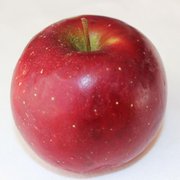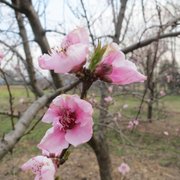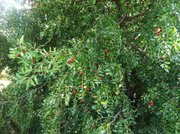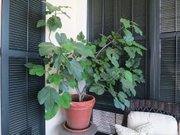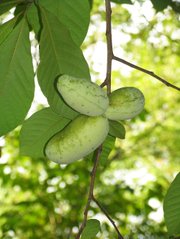"Grow your own" is a growing trend, and in addition to vegetables and herbs, more and more gardeners are trying their hand at fruit. Small fruits are much easier to fit into a small yard and to tend, but fruit trees are being planted in many gardens. Should you plant a tree?
Knowing something about the various fruit trees -- and which could live up to your expectations -- will make the decision easier.
Before you buy a tree (or two), consider the site you have for them:
• Good drainage is critical, and fruit trees need six to eight hours of sunlight a day to bear.
• Water will be needed in almost every case, so access to water is important, but the site also needs good drainage -- fruit trees won't thrive in a bog.
• "Air drainage" also matters -- a low spot in the yard becomes a frost pocket in very cold weather, and late frosts can take down a fruit crop. Planting on a slope or in an elevated area assures good air flow, which helps with frost protection.
Remember that weeds and grass steal light, water and nutrients from trees. These are not "set them and forget them" plants.
The top four fruit trees that Arkansans know about are apples, peaches, plums and pears.
The most popular is the peach, which is also the hardest to grow in Arkansas.
PEACHY KEEN?
Peach trees have very showy blossoms in the spring and are self-fruitful, meaning you only need one peach tree in order to have fruit. Production is usually increased by planting more than one variety rather than more of the same kind.
Peaches suffer from quite a few insect and disease problems. Brown rot is a terrible disease that attacks the fruit within days or weeks of harvest, particularly when we get rain near the harvest period. A dry summer is actually beneficial to peach growers since they maintain the water needed for growth, and the fruit itself stays dry.
Brown rot is not the only disease, and then there are insects to worry about -- plum curculio, peach tree borers and more.
All of these problems are curable but require a pretty rigorous spray program, which most home gardeners are not willing to undertake.
EASY AS PIE?
Apples and pears are much more forgiving, especially if you are willing to eat fruits that are not 100 percent blemish free. If you are growing fruit for home consumption, you can peel a brown spot or two.
Look for smaller varieties of apples and pears that at their mature height will still fit into a yard. Also look for a variety that resists fire blight.
Fire blight is a bacterial disease. There are sprays that can help to prevent it, but they aren't foolproof. Resistant varieties are available for many problems, and while resistance doesn't mean you will never have a disease or insect, these treatments definitely help.
The two most disease-resistant varieties of apples for Arkansas are "William's Pride" and "Enterprise." For pears, try "Harrow Delight," "Maxine," "Kieffer," "Magness" or "Moonglow."
A brochure with an extensive list of fruit varieties recommended for Arkansas is on the website of the University of Arkansas Division of Agriculture's Cooperative Extension Service: uaex.edu. Search for "FSA-6129."
If you want to branch out and try some less-common fruit trees that don't require spray programs, consider figs, pawpaw, persimmons and jujube trees.
FIGS
Fig trees should not be planted until early spring, since the past two colder-than-normal winters damaged many of the fig trees in the state. That suggests the state still might get weather cold enough to kill a young tree without established root structure.
Figs are self-fruitful and will bear fruit on new growth. Plant them in a more protected spot where they still get at least six hours of sunlight -- a sunny area near your house is good. But be aware that figs can produce a lot of fruit. If you don't harvest regularly, the fruits split and attract wasps, bees and flies. So plant them away from entryways or patio areas.
Prior to 1984, we considered fig trees more large bushes than trees, because winters typically pruned them back hard. Then milder winters set in, and we have seen huge fig trees being grown from as far north as Fort Smith through southern Arkansas. Northern counties can still grow figs, but they still typically freeze back annually.
"Brown Turkey" (also called "Texas Everbearing") and "Celeste" are the most common varieties available, but there are many more you can try. "Nero," "Blanche" (also called "White Russian") and "Conadria" are a few others.
PAWPAW
Pawpaw is a native tree with a very unusual fruit. They have been gaining in popularity.
They have large, almost tropical-looking leaves and a maroon bloom.
Pollinating pawpaw flowers can be a challenge. Although each flower contains both male and female parts, the female part matures before the pollen is ready. They therefore need two trees and the help of pollinators.
Meanwhile, bees show no interest in pawpaw flowers. Flies and beetles are the pollinators. Or you can hand pollinate, using a small, soft brush to transfer pollen to each stigma.
The resulting fruit can be quite large. Pawpaw fruit ripens between mid-August and mid-October, depending on the weather. When ripe, it is soft and yields easily to a gentle squeeze. The skin of the green fruit usually lightens in color as it ripens and often develops blackish splotches, which do not affect the flavor.
The yellow flesh is custardy and often described as a "custard banana."
Pawpaws don't last long once they are picked and so will never be commercially available, since they wouldn't last long enough to ship. If you can get to them before the squirrels and raccoons, eat them within two to three days.
The trees tend toward an upright growth habit and can reach 12 to 20 feet tall.
PERSIMMON
Although our native persimmon does produce edible fruit -- provided you eat them after a frost -- they are not the showiest tree for the home landscape. A better choice would be one of the Oriental persimmons.
Some varieties are self-fruitful and others require two varieties for pollination. Oriental persimmon fruit ripens from late August until early December, depending on the variety and weather conditions.
"Fuyu-Gaki" persimmon is the most widely planted cultivar in the world. When fully ripe, this fruit turns a crimson red with a blue blush. It is also self-fruitful.
Other self-fruitful varieties include "Great Wall," "Matsumoto" and "Gionbo", which has very large (4-5 inches), orange, conical, astringent fruits. Most Oriental persimmon trees grow about 15 feet tall and wide. They are disease- and insect-free for the most part, requiring a little thinning in the spring, and water and fertilization.
JUJUBE
Probably the least known, most easily grown home fruit is the jujube or Arkansas date (Ziziphus jujuba).
Native to China, the jujube is a medium size, deciduous tree, topping out at 25 to 35 feet tall. The tree does have some thorns on the branches, but overall it has a graceful, drooping growth habit with branches arrayed in a zigzag pattern.
The greenish-white flowers are small but fragrant and produced in large numbers from late spring into early summer.
Most jujube cultivars are self-fruitful but will produce better when two trees are in the area. The fruits can vary from round to elongated and from cherry-size to plum-size, depending on the cultivar. They have thin, edible skin surrounding whitish flesh similar to a date and are a mahogany color when ripe.
Each fruit has one stone that contains two seeds. When fully ripe, the fruit begins to soften and wrinkle. Jujube fruit are edible either fresh, dried or preserved in sugar or honey syrups.
The trees are extremely drought tolerant and have no pest problems. They are also winter hardy statewide, and rarely suffer from any late frost damage, since they bloom later in the season.
PLAN BEFORE YOU PLANT
If you want to try your hand at growing fruit trees, do your homework. Make sure you have ample sunlight and space -- they are trees after all. Fruit trees -- other than figs -- could be planted in the fall, but we often see the best variety available in late winter.
Start small. It is easier to maintain a few trees well than have a mess of overgrown trees that are not productive.
Also, be patient. Most fruit trees can take three to eight years to begin full production. The type of fruit tree, the age of the fruit trees you buy, and their vigor can determine production.
Dwarf trees come into production sooner than standard, large trees. Some gardeners are choosing to espalier their fruit trees, training them as an edible ornament or a living fence. This requires more work, because you must keep them in that form, but the results can be impressive.
Also look at newer options. Many breeders are working on fruit tree varieties that can be grown in containers or small spaces. Columnar apples are one example.
Janet B. Carson is a horticulture specialist for the University of Arkansas Cooperative Extension Service.
HomeStyle on 10/17/2015

